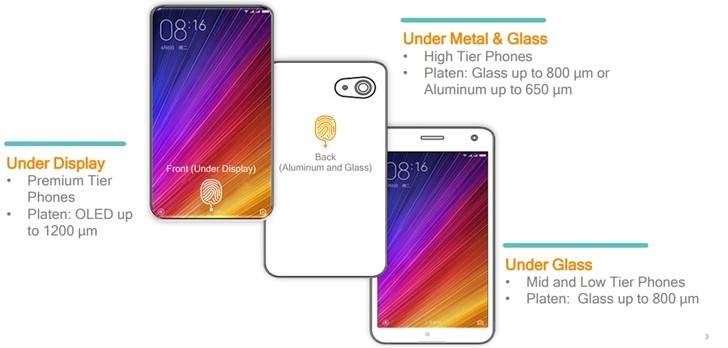
The biggest drawback of the Samsung Galaxy S8 was its fingerprint sensor placement. The technology to put the fingerprint sensor under the touch screen was just not possible by then. But now Qualcomm has officially announced the new Ultrasonic fingerprint sensor that works through glass screens.
Qualcomm says the fingerprint sensor will work through surfaces like OLED displays, metal, and glass surface. We will start seeing devices with this technology from early 2018 and they claim it will be compatible with all Qualcomm devices as well as some other platforms.
Based on the Piezoelectrical Effects, the Ultrasonic fingerprint sensor will also be able to detect your heart rate and blood flow making it more secure. And it works underwater as well. This new sensor can scan through an OLED panel that is of 1200 µm thick, metals of up to 800 µm thick and front glass cover of up to 650 µm of thickness. This is huge step comparing that with traditional fingerprint scanners that can only scan up to 400 µm of thickness.

According to Qualcomm’s schedule, manufacturers should start receiving samples of this new technology from this month. Likewise, devices should start releasing with this new fingerprint from the first half of 2018.
With bezel-less trend on the hype these days, manufacturers like Samsung and LG will benefit greatly with the release of this new technology. And with the ability to detect your blood flow and heart rate, it will also be more secure. Remember the hackers who used the photo of a man’s fingerprint to unlock their phone? They are going to have a harder time cracking this one.
As the leak suggested, Chinese brand Vivo already has a working prototype that was showcased at MWC Shanghai. The two companies, Vivo and Qualcomm, worked together to make this possible.







![Best Gaming Laptops in Nepal Under Rs. 250,000 (रु 2.5 Lakhs) [2025] Best Gaming Laptops Under 2.5 lakhs in Nepal [Feb 2025 Update]](https://cdn.gadgetbytenepal.com/wp-content/uploads/2025/02/Best-Gaming-Laptops-Under-2.5-lakhs-in-Nepal-Feb-2025-Update.jpg)
![Best Gaming Laptops in Nepal Under Rs. 120,000 (रु 1.2 Lakhs) [2025] Best Budget Gaming Laptops Under Rs 120000 in Nepal 2025 Update](https://cdn.gadgetbytenepal.com/wp-content/uploads/2025/05/Best-Budget-Gaming-Laptops-Under-Rs-120000-in-Nepal-2024-Update.jpg)
![Best Laptops Under Rs. 80,000 in Nepal [2025] Best Laptops Under 80,000 in Nepal March 2025 Update](https://cdn.gadgetbytenepal.com/wp-content/uploads/2025/03/Best-Laptops-Under-80000-in-Nepal-March-2025-Update.jpg)
![Best Gaming Laptops in Nepal Under Rs. 200,000 (रु 2 Lakhs) [2025] Best gaming lapotp under 2 lakhs Nepal Feb 2025](https://cdn.gadgetbytenepal.com/wp-content/uploads/2025/01/Best-Gaming-Laptops-Under-2-Lakh-Nepal-Feb-2025-Update.jpg)

![Best Mobile Phones Under Rs. 15,000 in Nepal [Updated 2025] Best Phones Under 15000 in Nepal 2024 Budget Smartphones Cheap Affordable](https://cdn.gadgetbytenepal.com/wp-content/uploads/2024/03/Best-Phones-Under-15000-in-Nepal-2024.jpg)
![Best Mobile Phones Under Rs. 20,000 in Nepal [Updated] Best Mobile Phones Under NPR 20000 in Nepal 2023 Updated Samsung Xiaomi Redmi POCO Realme Narzo Benco](https://cdn.gadgetbytenepal.com/wp-content/uploads/2024/01/Best-Phones-Under-20000-in-Nepal-2024.jpg)
![Best Mobile Phones Under Rs. 30,000 in Nepal [Updated 2025] Best Phones Under 30000 in Nepal](https://cdn.gadgetbytenepal.com/wp-content/uploads/2025/01/Best-Phones-Under-30000-in-Nepal.jpg)
![Best Mobile Phones Under Rs. 40,000 in Nepal [Updated 2025] Best Phones Under 40000 in Nepal 2024 Smartphones Mobile Midrange](https://cdn.gadgetbytenepal.com/wp-content/uploads/2024/02/Best-Phones-Under-40000-in-Nepal-2024.jpg)
![Best Mobile Phones Under Rs. 50,000 in Nepal [Updated 2025] Best Phones Under 50000 in Nepal](https://cdn.gadgetbytenepal.com/wp-content/uploads/2025/01/Best-Phones-Under-50000-in-Nepal.jpg)
![Best Flagship Smartphones To Buy In Nepal [Updated] Best flagship phone 2025](https://cdn.gadgetbytenepal.com/wp-content/uploads/2024/07/Best-Flagship-Phones-who-is-it-ft-1.jpg)